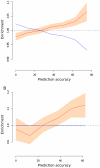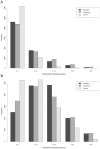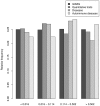Signatures of environmental genetic adaptation pinpoint pathogens as the main selective pressure through human evolution
- PMID: 22072984
- PMCID: PMC3207877
- DOI: 10.1371/journal.pgen.1002355
Signatures of environmental genetic adaptation pinpoint pathogens as the main selective pressure through human evolution
Erratum in
- PLoS Genet. 2011 Nov;7(11). doi:10.1371/annotation/ca428083-dbcb-476a-956c-d7bb6e317cf7. Ferrer-Admettla, Anna [corrected to Ferrer-Admetlla, Anna]
Abstract
Previous genome-wide scans of positive natural selection in humans have identified a number of non-neutrally evolving genes that play important roles in skin pigmentation, metabolism, or immune function. Recent studies have also shown that a genome-wide pattern of local adaptation can be detected by identifying correlations between patterns of allele frequencies and environmental variables. Despite these observations, the degree to which natural selection is primarily driven by adaptation to local environments, and the role of pathogens or other ecological factors as selective agents, is still under debate. To address this issue, we correlated the spatial allele frequency distribution of a large sample of SNPs from 55 distinct human populations to a set of environmental factors that describe local geographical features such as climate, diet regimes, and pathogen loads. In concordance with previous studies, we detected a significant enrichment of genic SNPs, and particularly non-synonymous SNPs associated with local adaptation. Furthermore, we show that the diversity of the local pathogenic environment is the predominant driver of local adaptation, and that climate, at least as measured here, only plays a relatively minor role. While background demography by far makes the strongest contribution in explaining the genetic variance among populations, we detected about 100 genes which show an unexpectedly strong correlation between allele frequencies and pathogenic environment, after correcting for demography. Conversely, for diet regimes and climatic conditions, no genes show a similar correlation between the environmental factor and allele frequencies. This result is validated using low-coverage sequencing data for multiple populations. Among the loci targeted by pathogen-driven selection, we found an enrichment of genes associated to autoimmune diseases, such as celiac disease, type 1 diabetes, and multiples sclerosis, which lends credence to the hypothesis that some susceptibility alleles for autoimmune diseases may be maintained in human population due to past selective processes.
Conflict of interest statement
The authors have declared that no competing interests exist.
Figures





Comment in
-
Human evolution: pathogen influence on human genetic variation.Nat Rev Genet. 2011 Nov 22;13(1):4. doi: 10.1038/nrg3134. Nat Rev Genet. 2011. PMID: 22105084 No abstract available.
References
-
- White TD, Asfaw B, DeGusta D, Gilbert H, Richards GD, et al. Pleistocene homo sapiens from middle awash, ethiopia. Nature. 2003;423(6941):742–747. - PubMed
-
- Harris EE, Meyer D. The molecular signature of selection underlying human adaptations. Am J Phys Anthropol Suppl. 2006;43:89–130. - PubMed
-
- Balaresque PL, Ballereau SJ, Jobling MA. Challenges in human genetic diversity: Demographic history and adaptation. Hum Mol Genet. 2007;16 Spec No.2:R134-9. - PubMed
-
- Voight BF, Kudaravalli S, Wen X, Pritchard JK. A map of recent positive selection in the human genome. PLoS Biol. 2006;4:e72. doi: 10.1371/journal.pbio.0040072. - DOI - PMC - PubMed
Publication types
MeSH terms
Grants and funding
LinkOut - more resources
Full Text Sources
Miscellaneous

